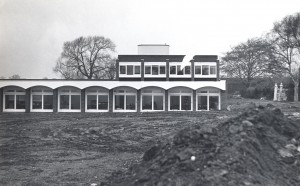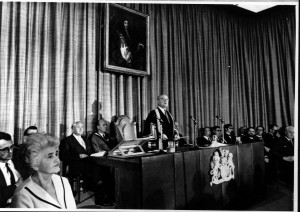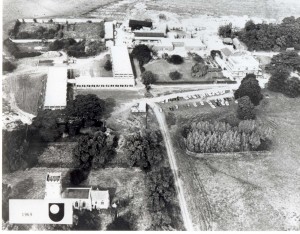Posted on February 9th, 2011 at 2:00 pm by Daniel Weinbren
Access to the online back issues of The Economist has been secured for OU staff. A glance through the archives indicates that in 1963 The Economist ‘warmly welcomed’ the OU and called it ‘one of the best things that he [Harold Wilson] has done’. In 1965 it said that the idea of a University of the Air had been ‘long supported by this journal’. In 1979 it reported that the OU had ‘moved away from the over-the-air teaching’ and noted the importance of regional centres and correspondence. To mark forty years of broadcasts it lapsed into ahistoric clichés. Although most of the course materials were printed and late-night television only started after a couple of years, here we are told that
OU lectures delivered remotely by hirsute professors, who dryly enumerated the laws of thermodynamics on late-night television, appealed only to the most dedicated of older people, determined to better themselves in their spare time
The median age of applicants in 1971 was 26-27 and if there were ‘bespectacled dons sporting dodgy double-knit jumpers’ then there was also some very well-presented teaching materials. Indeed an early criticism of the OU programmes was that they were ‘slickly professional’ (Conrad Russell, TES 1971).
While The Economist concludes that ‘the OU might turn out to offer a vision of the future’, an understanding of how that vision could be realised would be strengthened by a more sophisticated view of the development of the OU.
Posted in Complaints and concerns | No Comments »
Posted on February 9th, 2011 at 8:01 am by Daniel Weinbren
In 1976 TAD292 ,Art and environment, was first presented at the OU. It dealt with
the processes and attitudes of art not so much as these were evidenced in products of art but as they underlie the very act of doing art. This can be seen already from the titles which were given to some of the units in the course: ‘Boundary Shifting’, ‘Imagery and Visual Thinking’, ‘Having Ideas by Handling Materials’.
Students were offered a range of projects. These included the suggestion that the student stop activity and engage in listening. Another was to compose a score for sounds made from differently textured papers and a third was to enumerate the household’s activities and categorise these in terms of role and sex stereotyping. The aims of the course were attitudional, sensory and subjective rather than cognitive, relating to feeling rather than knowledge. They were ‘more phenomenological than conceptual in nature’. Assessment involved a student not only submitting the product, such as a self-portrait photograph, but also notes describing the process and rationale. The criteria were not specific but involved formulations including enthusiasm, imagination and authenticity. This course took the OU some way from the image of standardized, central control. Read the rest of this entry »
Posted in Ideas | 1 Comment »
Posted on February 8th, 2011 at 11:08 pm by Daniel Weinbren
Teens studying at the OU is being promoted by the OU but it wasn’t always that way. Originally the OU was for over-21s only and there was some concern about allowing younger people to study through the OU. However, after the age of majority was lowered to 18 and when the Minister of Education, Margaret Thatcher, promoted the idea, a pilot group of younger students were permitted to study. They were the subject of close study in order to see if younger people should be encouraged. One of those who worked on the project was Alan Woodley, pictured. Over time attitudes towards younger students have changed and now they are welcomed.
Posted in Methods | No Comments »
Posted on February 5th, 2011 at 11:12 pm by Daniel Weinbren

Following a leader in The Times Higher on 3 December 1971 which attributed the origins of the OU to Harold Wilson’s speech of 1963, a letter from Laurence Edwards was published in the newspaper the following week, 10 December 1971. Edwards claimed that Wilson was not first British politician to enthuse about an open university. Rather, he wrote, ‘the idea owes its inception to a meeting at the Liberal Party Council at least a year earlier as any Liberal pamphlet for the year 1962 can amply demonstrate’. The Liberal Democrat History Group Secretary helpfully investigated this claim and has concluded that the Liberal Party manifestoes for the 1959 or 1964 General Elections did not contain a commitment to set up anything like the OU (although this was also true of the Labour Party manifesto as the idea only appeared there in 1966). Furthermore, Jo Grimond, in The Liberal Future, Faber and Faber, London, 1959, p. 127 (written when he had been Liberal Party leader for three years) argued that
of adult education I am sceptical. The intense desire for knowledge which existed fifty years ago seems to have evaporated or is now satisfied by TV and the papers. By all means let universities run extra-mural courses but modern adult education of people over twenty-five is largely a matter of providing ‘third programmes’ in various ways outside the educational system itself.
The Liberal Democrat History Group has also checked the list of Liberal Publications Department pamphlets issued between 1956-76, as contained in the catalogue of the British Library and there is no publication listed which deals with the question of university, adult or further education.
Perhaps Edwards’ was misremembering events. If you know the sources to which he was referring, do let us know.
Posted in Ideas | No Comments »
Posted on February 4th, 2011 at 11:59 pm by Daniel Weinbren
With new research indicating the value to students of using the micro-blogging site Twitter the case for blending learning and for encouraging learning through to collaboration appears to be further cemented into place. The paradigm shift from teaching to learning did not occur because of the technologies but because of their application by those interested in innovative educational concepts and flexible learning modes. What part has the OU has played in the shift towards the mainstreaming of these ideas?
Read the rest of this entry »
Posted in Methods | No Comments »
Posted on February 4th, 2011 at 3:16 pm by Daniel Weinbren
 Research from the Higher Education Policy Institute (a thinktank created on 1 November 2002 and which says that it is the ‘UK’s only independent think tank devoted exclusively to higher education’) indicates that 40% of students from England who were accepted on to university degree courses last year achieved lower grades than two Es at A-level. The comparable figure in 2003 was 24%. Bahram Bekhradni, the HEPI director, suggested that the values of the OU have become mainstream when he said “It is one of the strengths of the UK higher education system – and a feature that sets it apart from most others in Europe – that second-chance higher education is possible”.
Research from the Higher Education Policy Institute (a thinktank created on 1 November 2002 and which says that it is the ‘UK’s only independent think tank devoted exclusively to higher education’) indicates that 40% of students from England who were accepted on to university degree courses last year achieved lower grades than two Es at A-level. The comparable figure in 2003 was 24%. Bahram Bekhradni, the HEPI director, suggested that the values of the OU have become mainstream when he said “It is one of the strengths of the UK higher education system – and a feature that sets it apart from most others in Europe – that second-chance higher education is possible”.  As Bekhradni worked at the Department of Education and Science for nearly 20 years and presided over the RAE it is likely that he is aware of the history of the term ‘second chance’ (as it is used in para 23 of the Executive Summary). It was often applied to the OU. In 1971 over 30% of the first students at the OU had less than two A levels or equivalent. The report also noted that plenty of people who apply for higher education, even though they have fewer than 80 tariff points, are not offered a place at a conventional university.
As Bekhradni worked at the Department of Education and Science for nearly 20 years and presided over the RAE it is likely that he is aware of the history of the term ‘second chance’ (as it is used in para 23 of the Executive Summary). It was often applied to the OU. In 1971 over 30% of the first students at the OU had less than two A levels or equivalent. The report also noted that plenty of people who apply for higher education, even though they have fewer than 80 tariff points, are not offered a place at a conventional university.
Posted in Ideas | No Comments »
Posted on January 28th, 2011 at 10:27 am by Daniel Weinbren
 Collaborate to compete. Seizing the opportunity of online learning for UK higher educationis a recently produced report to HEFCE by the Online Learning Task Force. The authors include OU Vice-Chancellor Martin Bean, Sir Alan Langlands, Chief Executive, HEFCE, a number of academics and representatives from Microsoft, Apple and also the President of Higher and Professional Education, Pearson Education Ltd.
Collaborate to compete. Seizing the opportunity of online learning for UK higher educationis a recently produced report to HEFCE by the Online Learning Task Force. The authors include OU Vice-Chancellor Martin Bean, Sir Alan Langlands, Chief Executive, HEFCE, a number of academics and representatives from Microsoft, Apple and also the President of Higher and Professional Education, Pearson Education Ltd.
The report employs understandings of the history of the OU noting both that ‘this country set a world standard for distance learning by establishing, some 40 years ago, the Open University’ and that
The Open University has developed its own style of online learning called ‘supported open learning’ giving its 250,000 students flexibility to study when and where suits them best. This is in keeping with the university’s founding mission to be open to people, places, methods and ideas.
The report also noted that
Learners are increasingly able to navigate high quality, open and online resources and can do this through social networks, which in some cases are more supportive contexts in which to develop skills. New broadcast and distribution channels such as iTunes U17, Youtube and Wikipedia demonstrate this trend. Learning environments and contexts are becoming increasingly participative and the learner’s contribution is highly valued by teaching professionals….The Open University, for example, has successfully attracted students by placing small segments of content for informal learning on iTunes U.
Can you help us explore the history of this trend of support for informal learning so that we can better comprehend it and assess the impact of the OU? Read the rest of this entry »
Posted in Ideas, Methods | No Comments »
Posted on January 18th, 2011 at 11:17 am by Daniel Weinbren
Professor Walter James, the founder Dean of the Faculty of Educational Studies, born in 1924, died on Christmas Day 2010.
The son of a railway fireman, later an engine driver, Walter James attended Grammar School due to a scholarship but had to leave aged 16 as his family could not afford for him to remain in full-time education. He joined the Royal Navy aged 18 and after war service he trained as a teacher. He was a mature student at Nottingham University between 1952 and 1955 and then a lecturer in adult education there. While working at the Department of Adult Education, Nottingham he worked on a project to integrate television broadcasts and correspondence materials into a university course. Associated Television and the University of Nottingham produced a 13-week course which 1,250 people completed. It included programmes, written notes, two tutorials and a residential weekend attended by 200 people.
Following his appointment to the OU he sought out others who had used a variety of distance teaching techniques, visiting both the University of Wisconsin Extension and the USA Forces Institute, a centre for correspondence-based education which was based nearby and had links with the Wisconsin. Read the rest of this entry »
Posted in People | No Comments »
Posted on January 17th, 2011 at 6:11 pm by Daniel Weinbren
 Gina Barreca noted that there are songs about the experience of attending college and university. However, there are not any commercial ones specifically about The Open University. If you know differently, or can supply the lyric sheets for ditties composed at summer school or for Christmas parties, do comment.
Gina Barreca noted that there are songs about the experience of attending college and university. However, there are not any commercial ones specifically about The Open University. If you know differently, or can supply the lyric sheets for ditties composed at summer school or for Christmas parties, do comment.
Posted in Complaints and concerns | No Comments »
Posted on January 13th, 2011 at 3:34 pm by Rachel Garnham
 A moving tribute to the Geoffrey Crowther building has been paid here. The building on the OU’s Walton Hall campus in Milton Keynes is currently being demolished. It was built in in 1971 with its extension opened in the early 1980s.
A moving tribute to the Geoffrey Crowther building has been paid here. The building on the OU’s Walton Hall campus in Milton Keynes is currently being demolished. It was built in in 1971 with its extension opened in the early 1980s.
Lord Crowther of Headingley was the first Chancellor of the University until his death in 1972. He was installed as Chancellor at the first meeting of the Congregation of the University on 23  July 1969 at the Royal Society. This was combined with the award of the Charter by the Privy Council, and was attended by the Prime Minister to much fanfare. It was on this occasion that Lord Crowther gave his speech describing the new university as open as to people, places, methods and ideas: the University’s mission statement to this day.
July 1969 at the Royal Society. This was combined with the award of the Charter by the Privy Council, and was attended by the Prime Minister to much fanfare. It was on this occasion that Lord Crowther gave his speech describing the new university as open as to people, places, methods and ideas: the University’s mission statement to this day.
CORRECTION (14/02/2011): An official document from the University’s Estates Department provided the information for this post that the Geoffrey Crowther building was built in 1971. However, an observant reader of this blog contacted us to point out that as he was working in the building in 1969, this could not in fact be the case. A check of the aerial view of the campus from 1969 shows that indeed the building was in place then (on the left hand side of the picture).

1969 campus from the air
Posted in People | No Comments »








